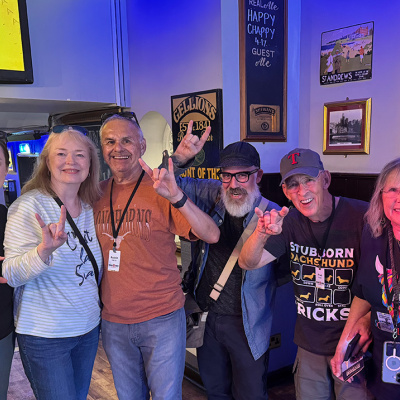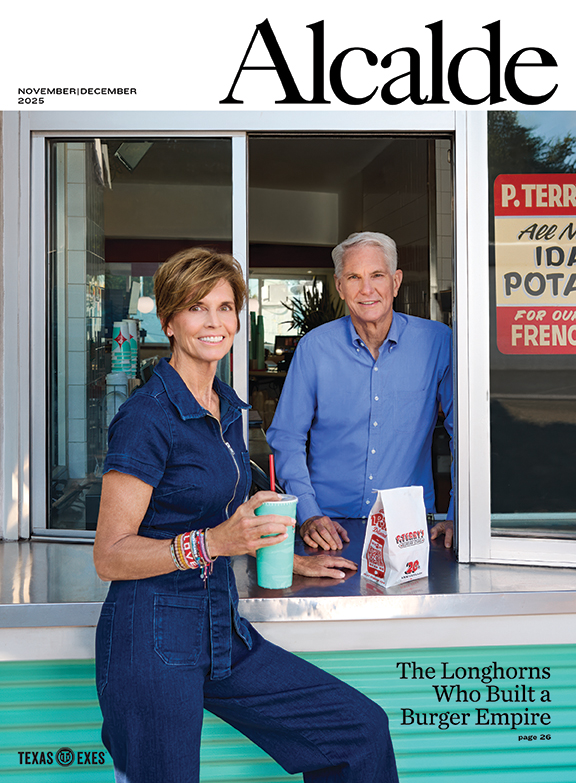Good Reads Q&A: This Author Tells Two Longhorn Stories to Confront a Common Misconception

When one hears the word “muscle,” the first person one probably imagines is a tanned, male bodybuilder who has taken anabolic steroids to superficially enhance his biceps and quads. Michael Joseph Gross wants to intervene with that instinct. With the help of two Longhorns, his new book proves that muscle matters to everyone.
Gross profiles three characters who make up the bulk (pun intended) of the book: Janice “Jan” Todd, Charles Stocking, and Maria Fiatarone Singh. Todd, PhD ’95, Life Member, is the chair of UT’s Department of Kinesiology and Health Education, as well as co-founder of the H.J. Lutcher Stark Center at UT, home to the largest archive in the world devoted to the study of physical culture. Also featured, Stocking is an associate professor in the Colleges of Education and Liberal Arts at UT.
Stronger: The Untold Story of Muscle in Our Lives will be published by Dutton on March 11, 2025. Ahead of the release, the Alcalde spoke with Gross about what his book offers to even the most skeptical reader.

Where did the first seed for this book come from?
I was a contributing editor at Vanity Fair magazine for a long time, reporting about technology and national security—a lot of pretty dark stories! I needed to get out of my head and into my body ... I started going to the gym in a different way than I had ever done before, [lifting weights]. I was so interested by what was happening [to my body] that I started looking for books to read about the experience I was having, and I just couldn’t find anything. It’s a classic story, but I decided to write the book that I wanted to read.
When I started looking at the science, I learned very quickly that, of all the different types of exercise, weight training was the one that the fewest people do and that the most people would get the most out of. I saw a need for the book.
How did you decide to structure the book as a series of three mini-profiles?
I knew that it needed to be a book that was built around not just the research that people had done, but also the lives that they had lived. We are all bombarded with well-meaning advice that can ultimately be dispiriting for a lot of people. But I think what people want in the project of meeting and remaking themselves physically is the company of people they can relate to. I read the work of hundreds of people, and these three stood out to me as being the most relatable, interesting, and sophisticated. Another thing they have in common is that they are world leaders in their fields, but they wear their learning humbly.
I was looking for people for whom, as you put it, I could tell their stories as profiles, but at the same time, the reader would be learning so much about their research—ideally not even realizing that they were learning all of it, but picking it up in the course of getting to know them.
How did you work to integrate the research into their stories?
For me as a writer, every story starts with a timeline, and every relevant piece of research gets an entry on the timeline. For Stronger, that timeline grew to be hundreds of pages, single-spaced. For example, when Jan Todd writes her dissertation on the surprising popularity of heavy resistance exercise among Victorian women, clustered right around that are timeline entries for things that are happening in medical exercise science, and who’s winning the Mr. America bodybuilding competition, and what is being discovered by archaeologists at Olympia in Greece. I’m able then to see how the life and work of each character overlap and intertwine, and that allows me to reach out and create ties among their stories.
Weightlifting has gained popularity recently, even on my social media feed. Why do you think that is?
Jan Todd and Charles Stocking are the start of the answer to that question. Todd had a leading role in opening weight training up to all kinds of women ... and Stocking came of age in a moment when weight training was becoming a part of athletic training in every sport. He worked his way through graduate school in the classics by coaching women’s soccer players and football players and volleyball players and Olympic track and field athletes—and learning how athletes in every single sport could make themselves better by making themselves stronger. And once those two things happened, it became possible for so many more people to imagine themselves lifting.
Why should people read this book, even if they aren’t gym rats?
Muscle decides whether you can do what you want to do in life, and that’s going to be true until the very last day of your life. If you want to protect your ability to stand up and go where you want to go, and also to do things for other people, then you have to take care of [your muscle], and the best way to take care of it, especially as we get older, is resistance training.
What I hope this book will do more than anything is give people a new way of seeing themselves with muscle a little closer to the center of who they are. We often think of ourselves mainly as our brains, and we forget that our minds and our muscles are not in conflict, as old ideas about “brain versus brawn” have made us think they are. Mind and muscle are best friends. One of the most important lines in the whole book is, “Think how the world could look different if every time you heard someone say ‘muscle,’ the first person you thought of was ... your grandmother.”
This interview has been edited and condensed.
CREDIT: Ladd Spiegel





